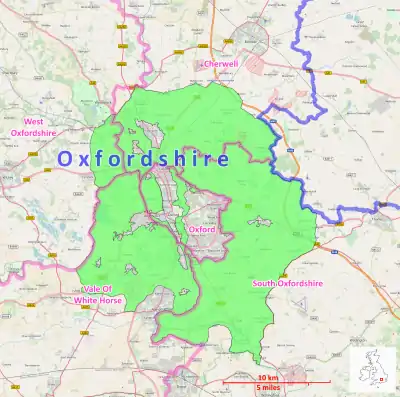Oxford Green Belt
The Oxford Green Belt is a green belt environmental and planning policy that regulates the rural space in Oxfordshire, within the South East region of England. It is centred on the city of Oxford, along with surrounding areas. Its core function is to control urban growth and development in and around the Oxford built-up area.[1] It is managed by the local planning authorities on basis of guidance from central government.

Geography
The green belt was first proposed in 1958, but only formalised and approved by central government in 1975.[2] Land area taken up by the belt is 66,868 hectares (668.68 km2; 258.18 sq mi), 0.5% of the total land area of England (2010).[3] All the Oxfordshire district council areas contain some portion, and it extends for some five miles from the city's limits. The smallest tracts are within the city and West Oxfordshire districts, with South Oxfordshire containing the largest expanse.
Key suburbs, villages and towns within the realms of the green belt include Dean Court, Kennington, Kidlington, Wheatley, and Yarnton. Landscape features and facilities within include River Thames, Cherwell and their flood-meadows, RSPB Otmoor, Culham Science Centre, Cutteslowe Park and the mini railway attraction, Shotover Country Park, Farmoor Reservoir, and St Margaret's Church and well.[4] Due to the belt lying wholly within the county border, responsibility and co-ordination lies with the district councils as these are the local planning authorities.
References
- Fawcett, Tony. "Green Belts: A greener future - Campaign to Protect Rural England". Archived from the original on 27 June 2018. Retrieved 30 December 2017.
- "CPRE - The Oxford Green Belt: Key Facts". www.cpreoxon.org.uk.
- "Green Belts in England: Key facts - A series of factsheets on England's 14 Green Belts".
- "Oxford Green Belt Study Final Report Prepared by LUC October 2015" (PDF). oxfordshire.gov.uk.